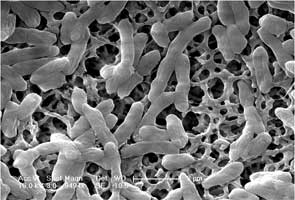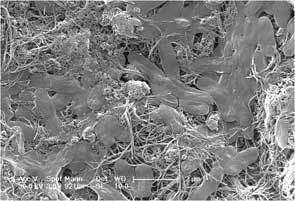| Posted: Aug 24, 2007 | |
Toxic nanotechnology - a problem that could result in surprising benefits |
|
| (Nanowerk Spotlight) The fight against infections is as old as civilization. Silver, for instance, had already been recognized in ancient Greece and Rome for its infection-fighting properties and it has a long and intriguing history as an antibiotic in human health care. Modern day pharmaceutical companies developed powerful antibiotics - which also happen to be much more profitable than just plain old silver - an apparent high-tech solution to get nasty microbes such as harmful bacteria under control. | |
| In the 1950s, penicillin was so successful that the U.S. surgeon general at the time, William H. Stewart, declared it was "time to close the book on infectious diseases, declare the war against pestilence won." Boy, was he wrong! These days, the U.S. Centers for Disease Control and Prevention (CDC) estimates that the infections acquired in hospitals alone (of all places! it's 2007 and we can't even make our hospitals safe - how scary is that?) affect approximately 2 million persons annually. In the U.S., between 44,000 and 98,000 people die every year from infections they picked up in hospitals. As our antibiotics become more and more ineffective researchers have begun to re-evaluate old antimicrobial substances such as silver. | |
| Antimicrobial nano-silver applications have become a very popular early commercial nanotechnology product. Researchers have now made a first step to add carbon nanotubes to our microbe-killing arsenal. | |
| Contrary to conventional thinking, scientists now suspect that there might be bacterial components to many diseases and disorders, from mental disorders to cancer and even obesity. What makes this even scarier is that, in an alarming trend, bacteria and other microorganisms that cause infections are becoming remarkably resilient and can develop ways to survive drugs meant to kill or weaken them. This antibiotic resistance is due largely to the increasing use of antibiotics. Just consider the fact that by some estimates 70% of U.S. antibiotics (25 million pounds) are given to farm animals - not to treat disease, but to promote slightly faster growth and to compensate for crowded and unsanitary living conditions. These antibiotics find their way, through our food, into our bodies. Antibiotics have even been found in breast milk. | |
| (By the way, you probably noticed that some Nanowerk Spotlights start with some fascinating nanotechnology discovery and then end up ranting about what's wrong with the world. Like this one. Fact is that we could deal with all of today's problems, be it pollution, global warming, energy, drinking water or third world hunger and medical care, with existing technologies. Nanotechnologies will massively improve our technological capabilities to do so but waiting for them can be no excuse for not acting today. The issue is not inadequate technology, it's the lack of political will. | |
| Let's take the twisted logic of the gun lobby and put it to good use: Technology doesn't help people - people do. And people selling nanotechnology stock newsletters or organizing "clean something" nanotech conferences under the pretext of "it's all in the interest of a better future" are profiting handsomely from our comfortable inertia because why make difficult decisions today if nanotechnology is going to magically fix all our problems tomorrow? And we all can get rich in the process by buying the right nanotechnology stocks.) | |
| We wanted to talk about something positive, though: toxic carbon nanotubes (CNTs). The debate to what degree and under what circumstances carbon nanotubes are toxic is far from over. Researchers have now taken an interesting approach: if CNTs can kill human cells under certain conditions, can't this toxicity be used to develop anti-microbial applications? | |
| A team of researchers led by Prof. Menachem Elimelech, the Chair of the Department of Chemical Engineering and the Director of the Environmental Engineering Program at Yale University, has firmly established that single-walled CNTs (SWCNTs) can pierce bacterial cell walls. | |
| Specifically, by using highly purified, pristine SWCNTs with a narrow diameter distribution, they demonstrated that direct cell contact with SWCNTs can cause severe membrane damage and subsequent cell inactivation of E. coli bacteria. | |
| In contrast, the silver nanoparticles used in antimicrobial applications damage bacterial cells by destroying the enzymes that transport cell nutrient and weakening the cell membrane or cell wall and cytoplasm. Unfortunately, in practical applications, the pure silver nanoparticles are unstable with respect to agglomeration. In most cases, this aggregation leads to the loss of the properties associated with the nanoscale of metallic particles. | |
| "This is the first work to demonstrate antibacterial effects of single-walled carbon nanotubes" Elimelech tells Nanowerk. "Previous works were with human cells and other organisms. We also took great care in designing the experiments so the results are more conclusive. We prepared pristine, narrow-sized distribution, well-characterized SWCNTs." | |
| Elimelech points out that previous studies on toxicity of SWCNTs used commercial and/or poorly characterized SWCNTs. Impurities can play a role in toxicity, and impurities of commercial SWNTs are quite significant. | |
 
|
Scanning electron microscopy (SEM) images of E. coli. (left) Cells incubated without SWCNTs for 60 min. Cells were filtered and observed via SEM on the filter. (right) Cells incubated with SWCNTs for 60 min. (Images: Dr. Elimelech) |
| "Although our results show that the E. coli undergoes severe membrane damage and subsequent loss of viability due to SWCNTs, very little information is currently available with regard to the cytotoxic mechanisms of SWCNTs" says Elimelech. "Previous studies, mainly focusing on mammalian cells, have proposed three principal cytotoxic mechanisms: oxidative stress, metal toxicity, and physical piercing. In our study, we postulate that SWCNT aggregates caused irrecoverable damage to the E. coli bacteria by physical damage to the outer membrane of the cells, causing the release of intracellular content." | |
| There are two ways to look at these research findings: the negative one of course has to do with the fact that this is a further demonstration of the biotoxicity of CNTs. Let's close out on a positive note, though: Any discovery of new ways to make antimicrobial materials and applications is welcome news. While it is unlikely that we will see CNT-based microbe-killing medicine to replace ineffective antibiotics – although who knows – the potential use of antimicrobial surface coatings is huge, ranging from medicine, where medical device infection is associated with significant healthcare costs, to the construction industry and the food packaging industry. | |
| And studies such as this one will help us learn more about the toxicity of carbon nanomaterials, so that material engineers can design them with appropriate physical and chemical properties that reduce or eliminate toxicity. | |
| A paper on this research ("Single-Walled Carbon Nanotubes Exhibit Strong Antimicrobial Activity") has recently been published online in Langmuir. | |
 By
Michael
Berger
– Michael is author of three books by the Royal Society of Chemistry:
Nano-Society: Pushing the Boundaries of Technology,
Nanotechnology: The Future is Tiny, and
Nanoengineering: The Skills and Tools Making Technology Invisible
Copyright ©
Nanowerk LLC
By
Michael
Berger
– Michael is author of three books by the Royal Society of Chemistry:
Nano-Society: Pushing the Boundaries of Technology,
Nanotechnology: The Future is Tiny, and
Nanoengineering: The Skills and Tools Making Technology Invisible
Copyright ©
Nanowerk LLC
|
Become a Spotlight guest author! Join our large and growing group of guest contributors. Have you just published a scientific paper or have other exciting developments to share with the nanotechnology community? Here is how to publish on nanowerk.com.
